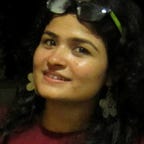Project #BodyFirst
The Brief and Vision
Our body houses our life, and is fundamental to our very existence — take away the body and life as we know and experience it ceases to happen. We use our body as a ‘tool of tools’ — a primary in how we interact with our environment and make sense of the world.
However, everyday living today seems to be governed by the cognitive — especially when one interacts with digital technologies — the hands and brains seem to be doing most of the work, while the rest of the body can be relegated to the background to continue to operate on auto-pilot, without us being actively conscious of it — so much so that we have literally started to lose touch with our very own bodies.
Can we design to encourage more active and holistic bodily engagement with the world, rather than get distracted from our own bodily, fuller selves?
Furthermore, there are increasing instances of reduced awareness of our environments — a ‘growing out-of-tune’ with our immediate environment, let alone our own ‘sense of self’ with respect to it. Are crises such as climate change and rising cases of clinical depression globally not some of the tell-tale signs of there being a serious disconnect of the ‘within and without’ — a disconnect with our own understanding of life, as individuals and as societies, with regard to the ways of the body and its relationships with its environment?
Can our ‘getting back in tune’ through the tool of our bodies help us be more consciously aware of our own impact on the environment and the world?
What tools can we build to encourage this ‘reconnect’?
Embodied interactions and tangible computing speak of involving the body, but as actuators, or receptors. How do we push the boundaries to go beyond the finger touch or the gestural? What about complimenting a body’s intelligences and senses rather than giving it a crutch of a merely amplified sense?
Can technology help the body become stronger, and evolve more organically and intelligently, and help it to ‘listen better’ to its environment and its own self rather than become, in its most glorious manifestation, an ‘exoskeleton’ to do acrobatics and war?
What technologies of the future can we build to encourage these integrations?
Premise. The current theory and practice of Somaesthetic Design continues to be informed by Western philosophical thought such as Pragmatism and practices such as Feldenkrais and Eastern influences, such as Daoism. Given also the rich somaesthetic practices of the Asian, and especially of the Indian sub-continent, what can we learn from the practices that originated closer home such as Kalaripayattu, Yoga, and Ayurveda to inform this design space?
Pathways for exploration. Individual projects could explore this broader theme of ‘BodyFirst’ from the perspectives of:
(a) Body* as Technology**,
(b) Body and Technology,
(c) Technology as an extension of the Body, or
(d) Body as an extension of Technology.
where,
* ‘Body’ refers rather to the ‘soma’ —the living, sentient, purposive body — as the indispensable medium for all perception, as defined by Richard Shusterman.
**‘Technology’ is used as a generic term to imply methods, processes, systems or devices of application of systematic or scientific knowledge, and does not necessarily refer to modern-day (digital) technology.
The primary question we are asking as a project space is:
What if we started thinking and designing with our bodies rather than our minds?
Through individual lines of inquiry that are rather interdisciplinary in nature, the final and rather ambitious goal has been, through individual projects explorations and experiments, to come up with new and more informed guiding principles and exemplars for the future of designing with the body — in a way to arrive at a set of ‘Principles to Design for the Bodily’.
Six Themes for the Next Millennium by Juhani Pallasmaa (https://www.thefreelibrary.com/Six+themes+for+the+next+millenium.-a015718505) formed the ‘Initiation Text’ to inspire us to work towards such lofty ideals as authenticity and sensuousness — and reimagine how the human spirit could flourish and be nourished (along with all the living and non-living on earth), through envisioning these well-‘felt’ futures!
The final outcomes are to hopefully serve in:
- Extending the Design Space. Designing with the body through experiments of products and experiences that exemplify the approach of the #BodyFirst.
- Designing for designers. To help look at the ‘process’ of designing using more bodily conscious interactions.
Expectations.
Students as part of this project adopted the disciplines of:
- Practicing — one somatic practice on a daily basis (such as walking, swimming, meditation, or any such bodily, movement-based practice) — to be able to observe, document and understand first-hand how the body communicates, adapts, resists, and in essence changes everyday and over time.
- Documenting — the somatic practice every day (in a diary, vlog, or any other suitable format of choice)— to arrive at lived and experienced bodily insights that can critically inform the approach to an individual project.
- Journalling — pen down questions, queries, insights every day — to serve as a rich repository of ‘go-to’ probes that could come to the rescue whenever one needed to get ‘unstuck’.
- Reading — any fundamental text of choice, that one felt could inform them whether directly, or indirectly in their work every day — to help gain richer perspectives, make more insightful connections and most importantly, stay inspired!
